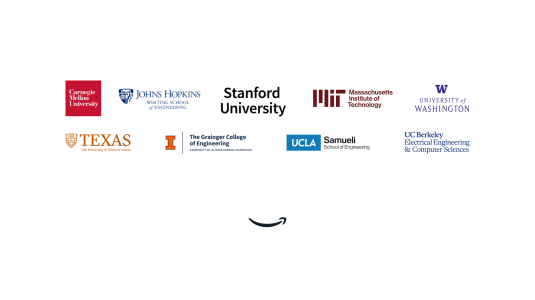Customer-obsessed science


Research areas
-
December 10, 20255 min readNew audio-processing technology is making entertainment more accessible for millions of viewers.
-
December 5, 20256 min read
-
-
-
November 20, 20254 min read
Featured news
-
NeurIPS 2025 Workshop on Evaluating the Evolving LLM Lifecycle2025Building infrastructure-as-code (IaC) in cloud computing is a critical task, underpinning the reliability, scalability, and security of modern software systems. Despite the remarkable progress of large language models (LLMs) in software engineering – demonstrated across many dedicated benchmarks – their capabilities in developing IaC remain underexplored. Unlike existing IaC benchmarks that predominantly
-
2025Understanding causal relationships among the variables of a system is paramount to explain and control its behavior. For many real-world systems, however, the true causal graph is not readily available and one must resort to predictions made by algorithms or domain experts. Therefore, metrics that quantitatively assess the goodness of a causal graph provide helpful checks before using it in downstream tasks
-
NeurIPS 2025 Workshop on New Perspectives in Graph Machine Learning2025Graph Neural Networks (GNNs) have proven to be highly effective for link and edge prediction across domains ranging from social networks to drug discovery. However, processing extremely large graphs with millions of densely connected nodes poses significant challenges in terms of computational efficiency, learning speed, and memory management. Thus making Graph Foundational Model very computationally expensive
-
CIKM 20252025Relevance in e-commerce product search is critical to ensuring that results accurately reflect customer intent. While large language models (LLMs) have recently advanced natural language processing capabilities, their high inference latency and significant infrastructure demands make them less suitable for real-time e-commerce applications. Consequently, transformer-based encoder models are widely adopted
-
NeurIPS 2025 Workshop on Evaluating the Evolving LLM Lifecycle2025Rigorous evaluation of Large Language Models (LLMs) is critical for their adoption in high-stakes applications, particularly in highly technical domains that require deep expertise and specialized training. The proliferation of LLMs from vari2025ous providers further underscores the need for comprehensive model performance benchmarking. Like many standardized tests and certification exams, several prominent
Collaborations
View allWhether you're a faculty member or student, there are number of ways you can engage with Amazon.
View all











































